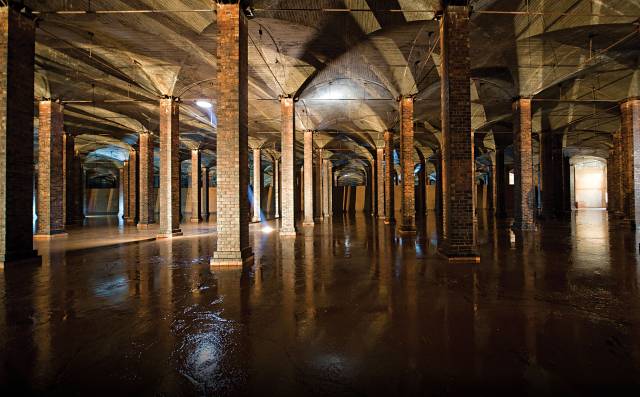
What lies beneath?

Centennial Park is one of Sydney’s biggest and most popular playgrounds for people of all ages. It has sports fields, ponds, walking areas and space for barbecues and picnics.
But underneath the grass and the wide spaces lies another world – the fifth oldest reservoir still in operation today as part of Sydney’s water supply system (the first was the Crown Street Reservoir completed in 1859, which is still in use).
The reservoir is on the State Heritage Register for a number of reasons.
It was started by the Public Works Department and in 1899 was completed by the newly incorporated Metropolitan Board of Water Supply and Sewerage which was established in 1888. It is one of Sydney Water’s second generation under- ground reservoirs; the sixth reservoir to be built in Sydney Water’s history.
The project was ‘planned to form a substitute’ for the Paddington Reservoir which was ‘too low and too small’ (Annual Report 1892:39). Centennial Park Reservoir No 1 presented a major improvement to the original Botany Scheme but actually operated as part of the expansion of the Upper Nepean Scheme and was considered a major technical achievement at the time.
Its capacity of around 80 megalitres replaced the inadequate six megalitres in the Paddington Reservoir (around three Olympic sized swimming pools). The Centennial Park Reservoir was also the first to exceed the capacity of the Crown Street Reservoir.
But the proposal caused some concern when originally discussed because of the effect it could have on the parklands. This was quickly overcome and the final design focused on aesthetics in order to not injure the general appearance of the Centennial Parklands which was one of the conditions under which the site was granted.
The completed project is an atypical oblong plan with axial dimensions of about 158 metres by 98 metres. The Reservoir is nine metres deep with a working water depth of about seven metres. It has a capacity of just over 80 megalitres (17 million gallons) which is around 32 Olympic-sized swimming pools.
As reinforced concrete had not been developed, the structure was constructed of mass concrete and brick with brick columns. The roof was constructed of groined arches of coke-cinder and cement concrete.
It features a former ornate “Chinoiserie pavilion roof hiding the central brick Ventilating Tower. The Pavilion or Chart House was designed by architect Charles Harding who also designed the Macquarie Street Hospital. The Pavilion was removed in the 1920s.
During the First World War, the elaborate perimeter fence was used to contribute to the collection of iron for ammunition production by donating the spearheads or spear points on top of the fence.
The hollow cast iron fence posts, known as fence ventilating standards, and the central Ventilating Tower served a crucial function in providing ventilation to accommodate changes in water volume and to prevent the air becoming foul by stagnation. The posts were designed to admit air
but to exclude ‘rodents and hands’.
Another of the early features of Sydney’s water supply was the Tank Stream which still exists underneath the city and which is available at times for tours. However, the Tank Stream was abandoned as a water supply because of pollution from rubbish, sewage and runoff from local business such as piggeries.
Sydney Water Board staff member Jodie Gillard took the underground tour with guide Ross Law starting with points of interest on the roads and footpaths at ground level and pointing out markers that indicated the Tank Stream was below where they were walking.
‘It was then time to get kitted up for the visit inside the Stream, so on with the hardhat, gumboots and harness. We then entered the visitors’ room to watch a video about the Stream and were told of the safety rules,’ said Jodie.
‘Everyone turned on their headlamps when we entered the stream because it’s completely dark in there and warm. Once down in the stream tunnel you become very aware of the history, the old stones that line the walls are marked with mason’s etchings; there are some original stones that lined the stream when it was still an above ground water source.
‘There had been some rain showers in the city so the Tank Stream had a nice flow and the banging of a manhole cover above was a reminder that we were currently standing under the middle of Hunter Street. Once you reach the smaller oval section of the stream, it is time to turn around and head back. On the way, keep an eye out for evidence of other visitors which is found in the form of little footprints left in the cement.
‘I had wanted to do the Tank Stream Tour for many years. I was not disappointed and loved every bit of it,’ said Jodie.
The Tank Stream was one of the most important factors that determined the location of Australia’s first permanent colonial settlement on the shores of Port Jackson. It served as the settlement’s first and main source of fresh water for 30 years. The Tank Stream is also a place of significance to the Gadigal, the traditional owners of the Sydney Cove area.
Article extracted from Freemason magazine, March 2014, pages 24 and 25.


